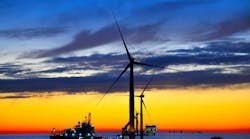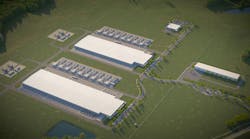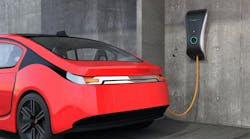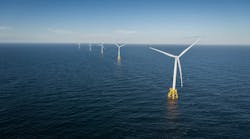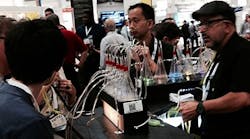Electrical Marketing’s reporters haven’t missed too many LightFairs since it started up in 1989, and from everything we can remember this was the biggest and busiest yet. The booths were bigger and the largest ones, including Acuity, Cree, Osram Sylvania, GE, Philips, Cooper Lighting, Lutron, and Juno Lighting/Schneider, consistently had big crowds. Following are the biggest trends we noticed at the show.
Communication systems that remotely connect individual lighting fixtures are spreading throughout the lighting world. As fixtures are outfitted with LEDs and other solid-state lighting sources, IP addresses and GPS location devices, end users will be able to remotely fine-tune lighting control, color and maintenance, send messaging and public safety alerts and offer customized lighting levels. Interconnected fixtures are basically just a node on a computer system with their own IP address and GPS coordinates. The systems operate via Wi-Fi and other communications protocols. Exhibitors marketing fixtures with these capabilities included GE, Osram, Hubbell Lighting, EYE Lighting, Sensity and Cooper Lighting/Eaton.
The quality of light emitted by LEDs continues to improve dramatically. It’s nothing short of remarkable how fast LEDs have become a viable alternative to traditional lighting sources. In the best-quality LEDs the light quality is as good as and in many cases better than what you get out of incandescents, HIDs and fluorescents. As long as the low-cost, bad-quality LEDs from offshore manufacturers don’t pollute the market, the big players have a huge opportunity for these products down the road.
Three challenges to watch with LEDs. The big challenge for distributors will be adapting to the fact that once they retrofit a lighting socket with an LED they might not get the chance to sell another light for that socket for 10 years, because that’s how long LEDs can last. This will require them to develop a different business model, because so many wholesalers relied on the stock business of replacement lamps that provided an acceptable ROI every two or three years.
The second big challenge is that while the LED chip that provides the light can last 10 years or even more, the lighting driver that powers it doesn’t always have the same lifespan. This has an impact on LED fixture warranties and forces all lighting pros to consider the source of the LED drivers. The third issue we heard about at the show were the challenges in matching LED light sources with lighting controls. LEDs and lighting controls don’t always speak the same language, and if they can’t communicate, electrical contractors and other installers will get call-backs. Lutron is investing a ton in its LED Institute to test LEDs to make sure they can talk to its controls.
The winners’ circle. The LightFair Innovation Awards always give attendees a great sampling of the newest lighting technology launched into the market over the past 12 months. The products are judged by an independent panel of lighting professionals who select winners for Most Innovative Product of the Year, Technical Innovation Award, Design Excellence Award, and Judges’ Citation Award, as well as product category winners. This year’s competition drew 261 entries. The most popular product categories were: Conventional, Retrofit and Replacement LED Lamps (31 entries): Recessed Downlights (32 entries); Outdoor Luminaires (28 entries); Controls, Building Integration, Site Automation & Distribution Systems (24 entries): and Commercial Indoor Troffers (27 entries).
The winners of the top awards were: Most Innovative Product of the Year, Acuity Brands, for its Open luminaire, an indoor suspended LED fixture; Technical Innovation Award, Dicon Lighting, for its Cielux T80 LED Track Light; Design Excellence Award, Hess America, for its Moon LED bollard; and the Judges' Citation Award, Osram, for its TRAXON Debut intelligent media system that creates personalized virtual reality spaces in dressing rooms.
Another big award presented annually at LightFair is GE’s Edison Award, which this year was presented to Robert Shook, Maureen Mahr, Jennifer Curtis and Kimberley Corbett-Oates of Schuler Shook Chicago, for lighting the City Performance Hall in Dallas. The winning project was one of three Awards of Excellence finalists. The other finalists were lighting designs for a San Francisco-based global investment firm designed by BANKS|RAMOS Architectural Lighting Design, San Francisco; and for Herscher Hall at Skirball Cultural Center in Los Angeles, designed by Lam Partners, Cambridge, Mass.

